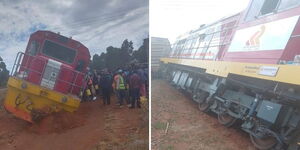The search for education can turn into a dangerous adventure for some learners in the country, with some forced to use some of the most dangerous roads on their way to school.
From encountering wild animals to facing attacks from dangerous groups such as bandits, learners often hope to make it to school safely and live another day to achieve their dreams.
Here is a list of some of the most dangerous routes and challenges Kenyan students face while going to school.
1. Wild Animals
Students from the Maasai community in Kajiado and Narok counties often have to walk long distances to school. During the journey, they often come face-to-face with wild animals like elephants, monkeys, and lions.
This is often explained by the environment that is conducive for wild animals and the number of game parks and reserves in the area.
For the Kassiola village in Kajiado, students often come face-to-face with elephants and hyenas. While many people are amazed by the sight of elephants, they are actually considered as one of the most dangerous animals because of their big size and feet that can tramp over their victims.
2. Bandits
Over the last few years, the Kenyan news cycle has been headlined by banditry attacks, especially in Laikipia, Baringo, Elgeyo Marakawet and West Pokot.
In places such as Kapedo, Baragoi, Lokori and Katilu, students often come face-to-face with bandits as they go to school in the morning hours. On February 18, 15 students of Tot Secondary in Elgeyo Marakwet sustained injuries after bandits attacked their school bus while on their way back from a trip.
In some of these areas, the government has often been forced to impose curfews so as to protect the residents and students living in the area.
3. Gangs
Occasionally, a section of students often have to face robbers and gangs as they commute to school in the early morning hours.
For example, in some parts of Gem, Yala, and parts of Luanda in Vihiga County, students are often attacked by gangs who are famously known to use pangas to attack their victims.
4. Boat ride
In 2019, the story of Kokwa Island in Baringo went viral as students were filmed embarking on a dangerous boat ride to school which is located over 10 kilometers away.
So delicate is the boat that it was revealed that they have to carry only 10 students at ago before the rest of the students are picked.
Additionally, due to the heavy rains that is experienced in parts of the Lake Victoria region, students in Kisumu have to use boats when the roads are flooded.
Apart from dealing with the dangers of the boat capsizing, they also come face-to-face with animals such as crocodiles and hippopotamuses.
5. Shifta Groups
In some places in Northern Kenya such as Mandera County, there are often cases of terrors attacks that are carried out by shifta groups and the Al Shabaab militia.
Some of these groups also use tactics such as placing Improvised Explosive Devices (IEDs) on the road to attack their victims. In January, over four people lost their lives as a matatu they were using ran over an IED.
Other areas that have faced such skirmishes include El Wak and Mpeketoni. More often than not, the government is forced to impose curfew hours to protect the students.












